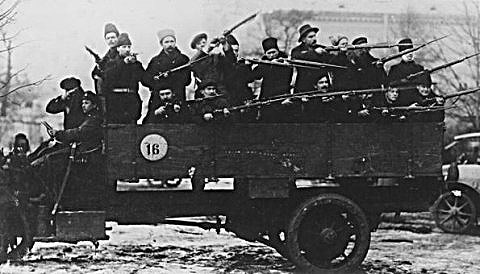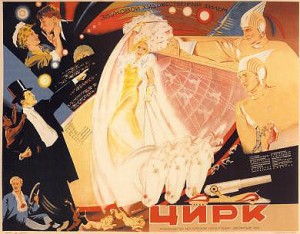The Ecstasy
Aug 14th, 2014 by amcadams
The communist dream came to fruition in the 20th century. Yet the revolutions that brought its adherents to power did not take place under the circumstances that Marx and Engels predicted. As a result, the interpretations of the dream and the institutions and incentives that were chosen to realize it were different as well.
7. Wednesday, September 17
Leninism: Part I
Discussion: With V. I. Lenin’s help, Marxism becomes a party in revolutionary Russia. We will discuss his challenging, foundational document about the communist party,“What is to be Done?” The essay’s purpose in 1902 was to motivate people to join Lenin’s army. Lenin mentions lots of parties and groups which will probably not be familiar to you. With the exception of the “Economists” and the “Social Democrats,” don’t worry about the others. How is Lenin’s image of revolution different from the one you find in the Communist Manifesto? Or the same? As you read Lenin, refer back to our readings from another founder, the Apostle Paul. Paul founded a revolutionary church. Lenin founded a revolutionary party.
Why might you have found Lenin’s argument appealing in turn-of-the-century Russia?
- Selections from V. I. Lenin, What is to be Done (1902): PRINT AND READ
- Rosenberg and Young, Transforming Russia and China. READ: Chapter I
- Benjamin Ginsberg, “Why violence works”: PRINT AND READ
- “What makes the Marine Corps Special?” READ
- Selections from the Apostle Paul: RE-READ
8. Monday, September 22
Leninism: Part II
Discussion: Lenin goes beyond the world of practical politics to imagine a communist future. Lenin’s pamphlet State and Revolution is a provocative contrast with What is to be Done? Unlike in 1902, when the Bolsheviks barely existed, Lenin was trying to prepare his followers psychologically for coming to power. As you read these excerpts, ask yourself about Lenin’s images of politics after the revolution: one corresponds to the overthrow of the old state and its replacement with a new form of state organization (“socialism”); the other is the final stage of human history (“communism”). Both periods show up in The Communist Manifesto, but in sketchier ways. Ponder Lenin’s view of the relationship between these two periods. How does one go from the first to the second?
- Selections from V. I. Lenin, The State and Revolution: PRINT AND READ
- Rosenberg and Young, Transforming Russia and China, Chapter II
9. Wednesday, September 24
NO CLASS
The Nanovic Institute is hosting an international conference in Rome. Participants include all of the major Catholic universities in post-communist Europe, especially from the Ukrainian Catholic University. The topic of the conference, which will be held at Notre Dame’s new building near the Colosseum, is the role of Catholic universities in educating students to be constructive citizens. As a result, I will have rushed out of class after Monday’s seminar and taken off for Europe. I will rejoin you on Monday, September 29.
10. Monday, September 29
Discussion: Great Writing, Persuasive Criticism George Orwell is one of the best stylists in the English language. His works are deceptively easy to read. Most people cannot write like this. I want you to try. Why does anyone take the time to engage in the brutal act of writing? Great writing is never neutral. That’s what makes it great. Readings from George Orwell:
- “Why I write” PRINT AND READ
- George Orwell: Facsimile (handout)
- Mystery Facsimile (handout)
- “Politics and the English Language” PRINT AND READ
11. Wednesday, October 1
Stalin, the Formation of the Soviet Union, and the Declaration of Socialism: Part 1
“I congratulate the Magnitogorsk workers and executive staff on their first important victory. Forward, comrades, to new victories!” J. Stalin (Pravda, May 19, 1931)
In this section, we discuss the views of an American participant in Stalin’s “heroic” construction of socialism. It is possible to view this period as a second Russian Revolution.
- John Scott, Behind the Urals: READ (read as much as possible)
- Video on “USSR Industrialization”: WATCH (19 mins.). This video focuses on Magnitogorsk and includes commentary from John Scott
- Rosenberg and Young, Transforming Russia and China, pp. 120-134, 147-166, 189-209.
–FIRST ESSAY ASSIGNMENT: Your essay question is HERE —
12. Monday, October 6
Stalin, the Formation of the Soviet Union, and the Realization of Socialism: Part 2
In-Class Film: “The Circus” (1936): We meet at the Nanovic Institute to watch this intriguingly–even bizarrely–glorified depiction of Stalinism.
13. Wednesday, October 8
Stalin, the Formation of the Soviet Union, and the Realization of Socialism: Part 3
We begin to sense from Scott’s account that something is going wrong the ideal image of building Soviet socialism. What are the symptoms of this dysfunction and why are they occurring?
- Josef Stalin, “The Tasks of Business Executives” (February 1931): PRINT AND READ
- John Scott, Behind the Urals: READ (finish the book and don’t forget the very important appendix including his diary notes—his activities raise intriguing questions about his beliefs).
14. Monday, October 13
The Origins of Maoism in China
Discussion: We consider the similarities and differences between Lenin’s image of the march toward communism and that of Mao Zedong. Look closely at the two authors’ rhetorical style. What different features of revolutionary activity do they emphasize? Which ones are less prominent? Under what conditions would you support them?
- Mao Zedong, “Report on the Investigation of the Peasant Movement in Hunan”: PRINT AND READ
- Mao Zedong, “A Single Spark can start a Prairie Fire”: PRINT AND READ
- Rosenberg and Young, Transforming Russia and China. READ: Chapter III.
- Watch the first 10 minutes of this video to get a general sense for the period we are discussing: WATCH
Ω
NOTE: Please turn off and do not use your technology during class. This includes electronic devices of any kind, such as laptops, i-Pads, FBI trap-and-trace devices, cell phones, Kindles, transistor radios, video cameras, video games, or other personal digital devices.


